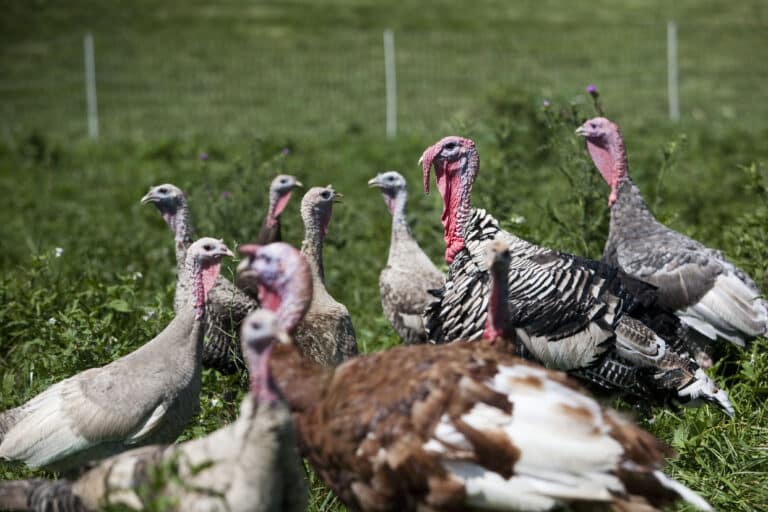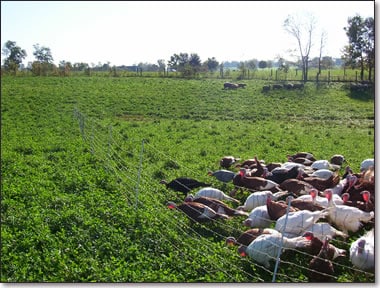The noticeably shorter days post-equinox lead me to think about fall holidays and our turkeys, as they’re nearly ready for harvest, and we’re already taking your preorders on the Elmwood Stock Farm website. The general scope of this year’s flock was decided before the pandemic settled upon us. This population goal was based on a review of previous years’ production and sales records and a little bit of guessing.
The turkey hatchlings have grown well. In fact, both Elmwood Stock Farm’s home-hatched heritage turkeys and the broad breasted turkeys are doing great. They probably benefited from the hot, dry summer, not to mention the careful care they receive here.
Now on pasture, any attempt to accurately count the turkeys is futile at best, but we do attempt. We line up the feed troughs end-to-end and fill them with food. Lupe and I walk along either side, counting both sides of the trough as the birds eat, but with all their jockeying for position, it is still only an estimate. We each write down the number before showing the other to see how far apart they are. In the last couple of years, we’ve gotten pretty close.
Timing their sizing up for Thanksgiving meals is our challenge. We want to bring them along, but not too fast. Under the veil of the first year of a global pandemic, we will work to match our offerings with your plans, which no doubt look different than in years past.

On our Central Kentucky farm, we maintain two flocks of turkeys: rare heritage turkeys, which we breed here, and broad breasted turkeys, which come to us as day-old poults (baby turkeys) from a hatchery outside Cincinnati.
The heritage turkeys come from genetics developed in the first 200 years of domesticated turkey farming in this country. These birds lay eggs in spring only, and we incubate and hatch them, then rear them to be full grown before winter, mimicking the development pattern of their wild cousins. Their slower-growing nature and greater ratio of dark meat to light—not conducive to commercial farming situations—made these birds fall out of favor as industrialized farming took hold in this country. The local food movement and interest in small-scale, sustainable farming brought heritage breed turkeys back from extinction, essentially.
The turkey hatchery outside Cincinnati supplies little, backyard operations like ours along with commercial-scale clients. The broad breasted bronze turkeys are completely different birds than the heritage turkeys. Their productive capacity is to be respected, especially in a pandemic, so we can start with them.
The broad breasted bronze we raise are less industrialized than the all-white turkeys. We think the turkey breeders lost some of the meat’s flavor when they selected birds for all white feathers. (White feathers don’t leave dark pigment spots on the skin associated with the feather follicle, which grocery-store customers prefer.) The bronze birds may be heartier outdoors, as well, which is important in our pasture-raising system. These turkeys do get big fast—a force to reckon with when walking amongst a hundred or more this time of year.
The heritage turkeys we hatch in the spring—primarily Narragansett and a few Bourbon Red and Slate—grow more slowly than the broad breasted bronze and never get as big, but they provide a rich-tasting treat. Their coloring and behavior are much like wild turkeys, yet they are amazingly calm in domestication, even needing the security of a shelter and their flock.

As the turkeys go through their ugly duckling adolescent phase into adulthood, they work amongst themselves to finalize their pecking order with definite alpha males and subordinate hens. Our outdoor system gives them room to express their turkeyness and give others space to stay out of the fray.
Rows of roosting rails run the length of their moveable shelters, and the turkeys instinctively seek their places in their shelters each night. We close the sides at night until the turkeys get bigger because of an owl—a persistent nocturnal predator—too close to the flocks for our comfort.
Daily feed intake records indicate the turkeys must be growing well. It’s kinda hard to tell when you look at them every day. If they would only sit still during the day they would put on more weight, but they seem to not be able to.
With our collective holiday celebrations looking perhaps different this year, more intimate holiday celebrations are something we can all appreciate.
For the close family pods we know of—three generations with kids and grandkids all living in the same neighborhood—we plan to have nice 20-pound turkeys with lots of white breast meat to carve, dark meat for leftovers, and bones to pick on for a couple of days and then turn into stock. For gatherings of smaller families or close friends, the darker-meat heritage birds offer amazing flavors and plenty of breast meat.
One food trend we’ve seen come out of the pandemic is that more of you have realized that turkey tastes great all year. Customers have bought up our stock of breast, thigh and leg packs to cook at home.
We are now taking holiday turkey orders, trying to decide how many turkeys to keep whole for the traditional holiday big bird and how many to have packaged as individual cuts to enjoy anytime. In short, we’re asking you to preorder sooner rather than later, before your prefered turkey size is made into individual cuts. This will help us to plan within our harvest schedule. When the pandemic first hit, our turkey processor filled up his calendar for the rest of this year and next. We have our dates reserved to provide wholesome, organic turkey for you, whatever form breaking bread with family and friends takes on this year.
From what we can tell, we are one of only a few farms on this continent going to all the work to provide wholesome, organic heritage turkeys for your enrichment. Place your order now so we can save yours for you. —Mac Stone



Made with 
